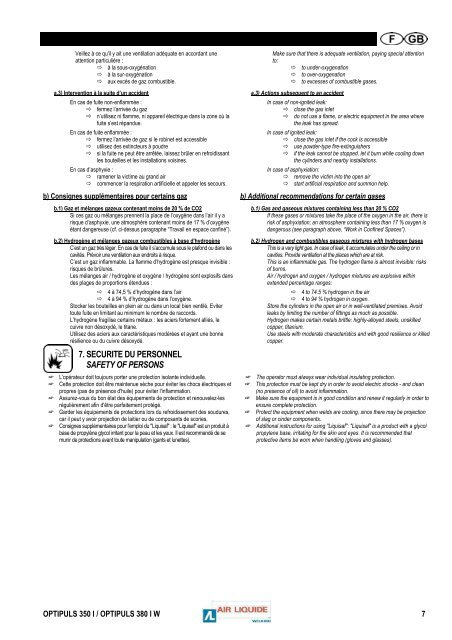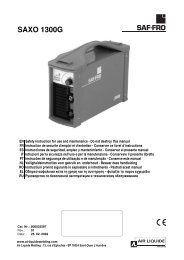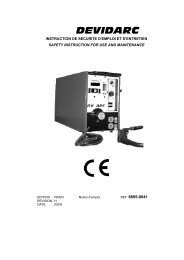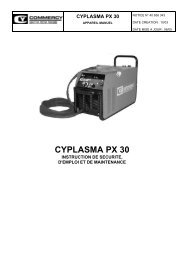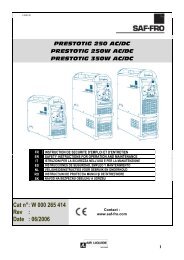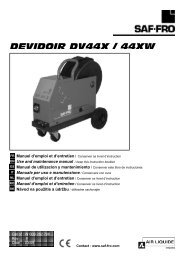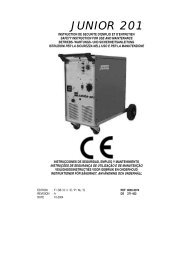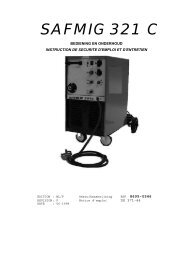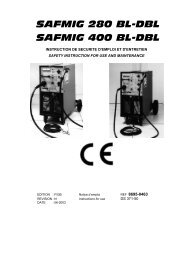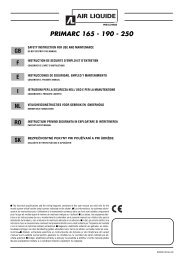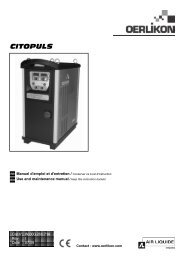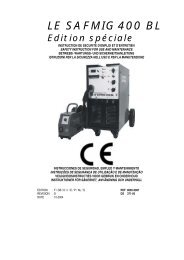5. SECURITE CONTRE LE FEU /PROTECTION FROM FIREEloignez les produits et les équipements inflammables de la zone de projectionsprovenant de l'arc, ou protégez-les.Ne pas souder ou couper à proximité de conduit d'aération, de conduite de gaz etautre installation pouvant propager le feu rapidement.En règle général, l'opérateur doit avoir un extincteur à proximité de lui. L'extincteurdevra être compatible avec le type de feu susceptible de se déclarer.Assurez-vous du bon positionnement de la connexion de masse. Un mauvais contactde celle-ci est susceptible d'entraîner un arc qui lui même pourrait entraîner unincendie.6. SECURITE D’EMPLOI DES GAZ /SAFETY IN THE USE OF GASESRemove inflammable products and equipment from the area where arc spatter mayoccur, or protect them.Do not weld or cut near a ventilation pipe, gas pipe or other installation which mightcause the fire to spread quickly.As a general rule, the operator should have a fire-extinguisher near him. The fireextinguishermust be compatible with the type of fire which may break out.Make sure of the proper positioning of the ground connection. If this has a faultycontact, it may cause an arc which itself could cause a fire.a) Consignes communes à l’ensemble des gaz a) Recommendations for all types of gasa.1) Risques encourusDe mauvaises conditions d’utilisation des gaz exposent l’utilisateur à deuxdangers principaux, en particulier en cas de travail en espace confiné : le danger d’asphyxie ou d’intoxication le danger d’incendie et d’explosiona.2.) Précautions à respecter Stockage sous forme comprimée en bouteillesConformez-vous aux consignes de sécurité données par lefournisseur de gaz et en particulier : les zones de stockage ou d’emploi doivent posséder unebonne ventilation, être suffisamment éloignées de la zone decoupage soudage et autres sources de chaleur, et être àl’abri d’un incident technique ; arrimez les bouteilles, évitez les chocs ; pas de chaleur excessive (> 50° C). Canalisations et tuyauteries vérifiez périodiquement l’étanchéité des canalisations fixesainsi que des tuyauteries en caoutchouc ; ne détectez jamais une fuite avec une flamme. Utilisez undétecteur approprié ou, à défaut de l’eau savonneuse et unpinceau ; utilisez des tuyaux de couleurs conventionnelles en fonctiondes gaz ; distribuez les gaz aux pressions recommandées sur lesnotices des matériels ; ne laissez pas traîner les tuyaux dans les ateliers ; ils risquentd’y être détériorés. Utilisation des appareils n’utilisez que des appareils conçus pour les gaz utilisés ; vérifiez que la bouteille et le détendeur correspondent bien augaz nécessaire pour le procédé ; ne graissez jamais les robinets, manoeuvrez-les avecdouceur ; détendeur :• n’oubliez pas de purger les robinets de bouteillesavant de raccorder le détendeur• assurez-vous que la vis de détente est desserréeavant le branchement sur la bouteille• vérifier bien le serrage du raccord de liaison avantd'ouvrir le robinet de bouteille• n'ouvrez ce dernier que lentement et d'unefraction de tour. en cas de fuite ne desserrez jamais un raccord souspression, fermez d'abord le robinet de bouteille. Travail en espace confiné(tels que notamment galeries,canalisations, pipe-line, cales de navire, puits, regards, caves, citernes,cuves, réservoirs, ballasts, silos, réacteurs)Des précautions particulières doivent être prises avant d’entreprendredes opérations de soudage dans ces enceintes où les dangersd’asphyxie-intoxication et d’incendie-explosion sont très importants.Une procédure de permis de travail définissant toutes les mesures desécurité doit être systématiquement mise sur pied.a.1) Risks incurredFaulty use of gas exposes the user to two main dangers, especially whenworking in confined spaces : the danger of asphyxiation or intoxication the danger of fire and of explosiona.2.) Precautionary measures to comply with Storage in compressed form in cylindersComply with the safety instructions given by the gas supplier andespecially: the storage or use areas must be properly ventilated andsufficiently distant from the cutting/welding area and othersources of heat, and not be susceptible to technical incidents; fasten the cylinders securely, avoid impacts; no excessive heat (> 50° C). Piping and tubing routinely check the impermeability of the fixed piping as wellas the rubber tubing; never use a flame to detect a leak. Use an appropriatedetector or, in the absence of this, use soapy water and abrush; use conventional colors for the pipes, according to thedifferent gases; distribute the gas at the pressures recommended on theequipment instructions; do not leave hoses lying about in the workshops; they may bedamaged. Use of the equipment use only equipment which is designed for the gas used; check that the cylinder and the pressure-reducing valvecorrespond to the gas necessary for the process; never lubricate the cocks, handle them gently; pressure-reducing valve:• do not forget to bleed the cylinder cocks beforeconnecting the pressure-reducing valve• make sure that the pressure-reducing screwis loosened before connection to the cylinder• check that the coupling is properly tightenedbefore opening the cylinder cock• open the latter very slowly, a fraction of a turn. in case of leak, never loosen a fitting under pressure; firstclose the cylinder cock. Work in confined spaces(such as, in particular, tunnels,piping, pipe-lines, ship holds, shafts, manholes, cellars, cisterns, vats,tanks, ballasts, silos, reactors)Special precautions must be taken before any welding operations inthese enclosures where the dangers of asphyxiation-intoxication andfire-explosion are very great.A work-permit procedure defining all the safety measures must besystematically implemented.6 <strong>OPTIPULS</strong> <strong>350</strong> I / <strong>OPTIPULS</strong> <strong>380</strong> I W
Veillez à ce qu'il y ait une ventilation adéquate en accordant uneattention particulière : à la sous-oxygénation à la sur-oxygénation aux excès de gaz combustible.a.3) Intervention à la suite d’un accidentEn cas de fuite non-enflammée : fermez l’arrivée du gaz n’utilisez ni flamme, ni appareil électrique dans la zone où lafuite s’est répandue.En cas de fuite enflammée : fermez l’arrivée de gaz si le robinet est accessible utilisez des extincteurs à poudre si la fuite ne peut être arrêtée, laissez brûler en refroidissantles bouteilles et les installations voisines.En cas d’asphyxie : ramener la victime au grand air commencer la respiration artificielle et appeler les secours.Make sure that there is adequate ventilation, paying special attentionto: to under-oxygenation to over-oxygenation to excesses of combustible gases.a.3) Actions subsequent to an accidentIn case of non-ignited leak: close the gas inlet do not use a flame, or electric equipment in the area wherethe leak has spread.In case of ignited leak: close the gas inlet if the cock is accessible use powder-type fire-extinguishers if the leak cannot be stopped, let it burn while cooling downthe cylinders and nearby installations.In case of asphyxiation: remove the victim into the open air start artificial respiration and summon help.b) Consignes supplémentaires pour certains gaz b) Additional recommendations for certain gasesb.1) Gaz et mélanges gazeux contenant moins de 20 % de CO2Si ces gaz ou mélanges prennent la place de l’oxygène dans l’air il y arisque d’asphyxie, une atmosphère contenant moins de 17 % d’oxygèneétant dangereuse (cf. ci-dessus paragraphe “Travail en espace confiné”).b.2) Hydrogène et mélanges gazeux combustibles à base d'hydrogèneC’est un gaz très léger. En cas de fuite il s’accumule sous le plafond ou dans lescavités. Prévoir une ventilation aux endroits à risque.C’est un gaz inflammable. La flamme d’hydrogène est presque invisible :risques de brûlures.Les mélanges air / hydrogène et oxygène / hydrogène sont explosifs dansdes plages de proportions étendues : 4 à 74,5 % d’hydrogène dans l’air 4 à 94 % d’hydrogène dans l’oxygène.Stocker les bouteilles en plein air ou dans un local bien ventilé. Evitertoute fuite en limitant au minimum le nombre de raccords.L’hydrogène fragilise certains métaux : les aciers fortement alliés, lecuivre non désoxydé, le titane.Utilisez des aciers aux caractéristiques modérées et ayant une bonnerésilience ou du cuivre désoxydé.7. SECURITE DU PERSONNEL /SAFETY OF PERSONS L'opérateur doit toujours porter une protection isolante individuelle. Cette protection doit être maintenue sèche pour éviter les chocs électriques etpropres (pas de présence d'huile) pour éviter l'inflammation. Assurez-vous du bon état des équipements de protection et renouvelez-lesrégulièrement afin d'être parfaitement protégé. Garder les équipements de protections lors du refroidissement des soudures,car il peut y avoir projection de laitier ou de composants de scories. Consignes supplémentaires pour l'emploi du "Liquisaf" : le "Liquisaf" est un produit àbase de propylène glycol irritant pour la peau et les yeux. Il est recommandé de semunir de protections avant toute manipulation (gants et lunettes).b.1) Gas and gaseous mixtures containing less than 20 % CO2If these gases or mixtures take the place of the oxygen in the air, there isrisk of asphyxiation; an atmosphere containing less than 17 % oxygen isdangerous (see paragraph above, “Work in Confined Spaces”).b.2) Hydrogen and combustibles gaseous mixtures with hydrogen basesThis is a very light gas. In case of leak, it accumulates under the ceiling or incavities. Provide ventilation at the places which are at risk.This is an inflammable gas. The hydrogen flame is almost invisible: risksof burns.Air / hydrogen and oxygen / hydrogen mixtures are explosive withinextended percentage ranges: 4 to 74.5 % hydrogen in the air 4 to 94 % hydrogen in oxygen.Store the cylinders in the open air or in well-ventilated premises. Avoidleaks by limiting the number of fittings as much as possible.Hydrogen makes certain metals brittle: highly-alloyed steels, unskilledcopper, titanium.Use steels with moderate characteristics and with good resilience or killedcopper. The operator must always wear individual insulating protection. This protection must be kept dry in order to avoid electric shocks - and clean(no presence of oil) to avoid inflammation. Make sure the equipment is in good condition and renew it regularly in order toensure complete protection. Protect the equipment when welds are cooling, since there may be projectionof slag or cinder components. Additional instructions for using "Liquisaf": "Liquisaf" is a product with a glycolpropylene base, irritating for the skin and eyes. It is recommended thatprotective items be worn when handling (gloves and glasses).<strong>OPTIPULS</strong> <strong>350</strong> I / <strong>OPTIPULS</strong> <strong>380</strong> I W 7


